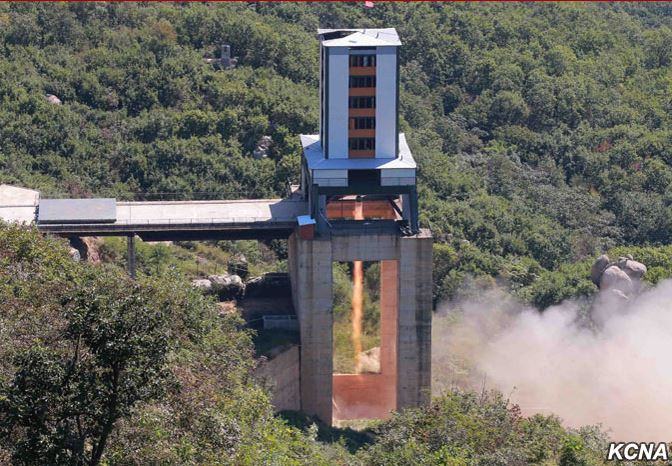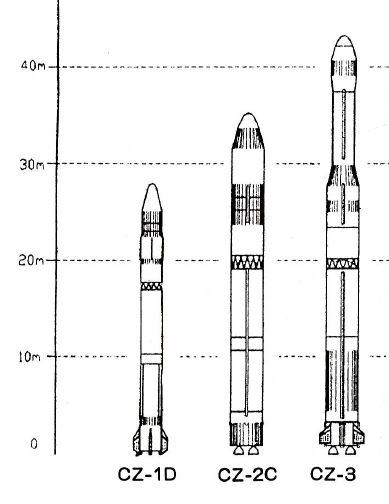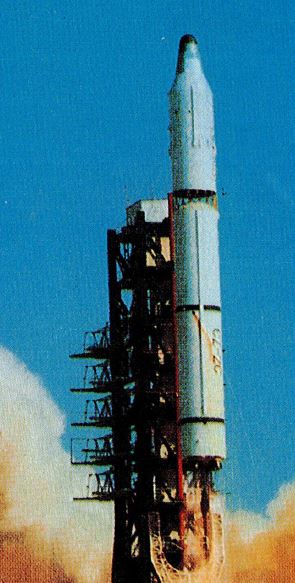North Korea announced on Tuesday that it had successfully tested a new, larger rocket engine. It says the engine will allow it build a more capable satellite launcher—a “rocket for the geo-stationary satellite.”
Many outside North Korea, however, see its satellite launch program as a way of developing technologies that it could use to build long-range military missiles.
What do we know about the new engine, and what might its implications be?
The New Engine
The test North Korea conducted was a ground test with the engine strapped to a test stand (Fig. 1). This is typical of tests of engines that are still in development.

Fig. 1. The test stand for North Korea’s engine test. The engine sits in the structure at the top; the flame from the engine is visible below it. (Source: KNCA)
The test announcement stated that the engine produced 80 tons of thrust. If true, that is roughly 2.5 times as much thrust as the engine it uses in its 1,300-km range Nodong missile, which produces about 30 tons. North Korea’s Unha satellite launcher, which has placed two small satellites in orbit (in 2012 and 2016), uses a cluster of four Nodong engines to power its first stage.
The Nodong engine is a scaled-up version of the Soviet Scud engine, and uses Scud-level propellants rather than more powerful propellants that are typically used in more modern rockets. However, the color of the flame coming from the new engine in photos of the test strongly suggests this engine does not use Scud propellant, but appears to use a more advanced propellant like UDMH or MMH. Using these propellants could increase the capability of the rocket since they can produce higher thrust per mass of propellant (more accurately, higher specific impulse).
Possible Implications for North Korea
What capabilities might North Korea develop with this new engine? To understand this, it’s worth looking at the development of China’s missiles and satellite launchers from the 1960s through the 1980s. China developed these rockets using an engine that had similar thrust and used similar propellant to the new North Korean engine.
LM-1/DF-4

Fig. 2 (Source: China Academy of Launch Technology (CALT))
North Korea’s current Unha launcher is similar in size and capability to China’s first satellite launcher, the Long March 1 (LM-1 or CZ-1). The LM-1was created by modifying China’s two-stage DF-4 intermediate-range ballistic missile. Design of the DF-4 began in 1965. The first successful LM-1 launch was in 1970, when it put China’s first satellite into orbit.
The size and mass of the LM-1—29 m long, 2.25 m diameter, 81 tons liftoff mass—are similar to North Korea’s Unha-3 launcher. The LM-1first-stage thrust was 104 tons (using four YF-1 engines) which is similar to the 120 ton thrust of the Unha first stage (using four Nodong engines). Because the LM-1 used more advanced propellants than the Unha, it was more capable, but could still only launch a small satellite (a couple hundred kg) into low Earth orbit (up to 400 km altitude). Like the Unha, it used a small third stage (on top of the two DF-4 stages) to accelerate the satellite to orbital speed.
The two-stage DF-4 missile appears capable of carrying a 500-1,000 kg nuclear warhead to 7,500-10,000 km. Since the DF-4 is more technically advanced than the Unha, it would be more capable than a two-stage Taepo Dong-2 (TD-2) missile, which is the name given to a missile consisting of the first two stages of the Unha (but which has not been tested in that configuration).

Fig. 3. LM-2 launch (Source: CALT)
LM-2/DF-5
China’s next step was to build larger rockets with considerably greater thrust. It developed the YF-20 engine, which produced a thrust of 70 tons at liftoff—similar to the “80 tons” announced for North Korea’s new engine. It used four of them in the first stage of its new Long March 2 (LM-2 or CZ-2) satellite launcher to give a launch thrust of 280 tons, and used a single modified version of the engine to power the second stage.
This engine was also used in the development of the DF-5 ballistic missile—China’s first true intercontinental range missile. The LM-2 and DF-5 were considerably larger than the LM-1 and DF-4, with a diameter of 3.35 m, a length of 32 m, and a liftoff mass of 190 tons.
Because of the larger thrust, the LM-2 was able to launch bigger satellites to higher orbital altitudes —it could lift more than a ton into orbit at altitudes between 500 and 1,000 km. And the DF-5 could carry a nuclear warhead to anywhere in the United States.
LM-3
By adding a third stage to the two-stage LM-2, China produced the Long March 3 (LM-3 or CZ-3), which was able to launch satellites intended for geo-stationary orbit while continuing to use the YF-20 engine. If North Korea is serious about wanting to launch geo satellites, as it indicated in its announcement of the engine test, it would need a launcher similar to the LM-3. Is there any evidence North Korea is interested in doing that?
Maybe. North Korea conducted its two Unha satellite launches from its Sohae launch facility. It originally built a gantry tower, which holds the missile prior to launch, that was about 40 m tall. That was enough to use with the Unha, which is about 29 m tall, and a rocket the size of the LM-2 or DF-5, which are about 32 m tall.
But by 2014 North Korea had done considerable construction at the launch site, including increasing the height of the gantry to about 55 m—able to accommodate a 50-m rocket. This would be needed for a launcher similar to the LM-3, which is 43 m tall. Unless Pyongyang was interested in accommodating a rocket with that capability, it would not need a taller gantry.
Conclusions
North Korea may be following a similar path for its rocket technology that China did 40 years ago. Its developments to date have given it a marginal satellite launch capability and long-range missile capability.
The development of an engine that can deliver a thrust near 80 tons, especially if coupled with a change to more advance propellants, would open up a new set of possibilities for North Korea. A similar advance was what allowed China to develop a more capable satellite launcher and a ballistic missile of true intercontinental range. If the claims about the capability of the new engine are true, this would represent another worrisome technical advance by Pyongyang.
There is speculation that North Korea may attempt another satellite launch around Oct. 10, which is the anniversary of the founding of the Workers’ Party of Korea. However, since it has just ground tested this new engine, it is unlikely the engine would be ready to use in a launch that soon. While the North has twice put a satellite into orbit, it is not clear if it has successfully communicated with either of them. As a result, Pyongyang may want to again use its existing Unha launcher to place a functioning satellite in orbit as a next step. It’s worth keeping in mind, however, that North Korea has frequently taken steps at odds with a more cautious step-by-step approach to development, so we could be surprised again.
